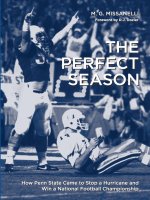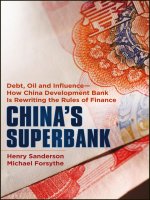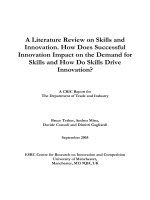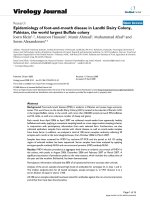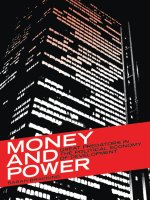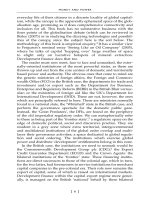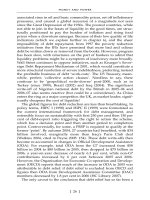Cohan money and power; how goldman sachs came to rule the world (2011)
Bạn đang xem bản rút gọn của tài liệu. Xem và tải ngay bản đầy đủ của tài liệu tại đây (4.21 MB, 899 trang )
Copyright © 2011 by William D. Cohan
All rights reserved. Published in the United States by Doubleday, a division of Random House, Inc., New
York, and in Canada by Random House of Canada Limited, Toronto.
www.doubleday.com
DOUBLEDAY and the portrayal of an anchor with a dolphin are registered trademarks of Random House,
Inc.
Portions of this work were previously published in Vanity Fair.
Grateful acknowledgment is made to the Columbia University Oral History Research Office Collection.
Jacket design by John Fontana
Jacket illustration by Serial Cut™
Title page photograph by Marco Di Fabio / Flickr / Getty Images
Cataloging-in-Publication Data is on file with the Library of Congress.
eISBN: 978-0-385-53497-0
v3.1_r1
TO QUENTIN, DEB, AND TEDDY
CONTENTS
Cover
Title Page
Copyright
Dedication
PROLOGUE
/ The Pyrrhic Victory
CHAPTER
1 / A Family Business
CHAPTER
2 / The Apostle of Prosperity
CHAPTER
3 / The Politician
CHAPTER
4 / The Value of Friendship
CHAPTER
5 / “What Is Inside Information?”
CHAPTER
6 / The Biggest Man on the Block
CHAPTER
7 / Caveat Emptor
CHAPTER
8 / The Goldman Way
CHAPTER
9 / A Formula That Works
CHAPTER
10 / Goldman Sake
CHAPTER
11 / Busted
CHAPTER
12 / Money
CHAPTER
13 / Power
CHAPTER
14 / The College of Cardinals
CHAPTER
15 / $10 Billion or Bust
CHAPTER
16 / The Glorious Revolution
CHAPTER
17 / It’s Too Much Fun Being CEO of Goldman Sachs
CHAPTER
18 / Alchemy
CHAPTER
19 / Getting Closer to Home
CHAPTER
20 / The Fabulous Fab
CHAPTER
21 / Selling to Widows and Orphans
CHAPTER
22 / Meltdown
CHAPTER
23 / Goldman Gets Paid
CHAPTER
24 / God’s Work
ACKNOWLEDGMENTS
NOTES
INDEX
Other Books by This Author
PROLOGUE
THE PYRRHIC VICTORY
Street has always been a dangerous place. Firms have been
in and out of business ever since speculators rst
W allgoing
gathered under a buttonwood tree near the southern tip of
Manhattan in the late eighteenth century. Despite the ongoing risks,
during great swaths of its mostly charmed 142 years, Goldman
Sachs has been both envied and feared for having the best talent,
the best clients, and the best political connections, and for its ability
to alchemize them into extreme profitability and market prowess.
Indeed, of the many ongoing mysteries about Goldman Sachs, one
of the most overarching is just how it makes so much money, year
in and year out, in good times and in bad, all the while revealing as
little as possible to the outside world about how it does it. Another
—equally confounding—mystery is the rm’s steadfast, zealous
belief in its ability to manage its multitude of internal and external
con icts better than any other beings on the planet. The
combination of these two genetic strains—the ability to make
boatloads of money at will and to appear to manage con icts that
have humbled, then humiliated lesser rms—has made Goldman
Sachs the envy of its financial-services brethren.
But it is also something else altogether: a symbol of immutable
global power and unparalleled connections, which Goldman is
shameless in exploiting for its own bene t, with little concern for
how its success a ects the rest of us. The rm has been described as
everything from “a cunning cat that always lands on its feet” to,
now famously, “a great vampire squid wrapped around the face of
humanity, relentlessly jamming its blood funnel into anything that
smells like money,” by Rolling Stone writer Matt Taibbi. The rm’s
inexorable success leaves people wondering: Is Goldman Sachs
better than everyone else, or have they found ways to win time and
time again by cheating?
But in the early twenty- rst century, thanks to the fallout from
Goldman’s very success, the rm is looking increasingly vulnerable.
To be sure, the rm has survived plenty of previous crises, starting
with the Depression, when much of the rm’s capital was lost in a
scam of its own creation, and again in the late 1940s, when
Goldman was one of seventeen Wall Street rms put on trial and
accused of collusion by the federal government. In the past forty
years, as a consequence of numerous scandals involving rogue
traders, suicidal clients, and charges of insider trading, the rm has
come far closer—repeatedly—to nancial collapse than its
reputation would attest.
Each of these previous threats changed Goldman in some
meaningful way and forced the rm to adapt to the new laws that
either the market or regulators imposed. This time will be no
di erent. What is di erent for Goldman now, though, is that for the
rst time since 1932—when Sidney Weinberg, then Goldman’s
senior partner, knew that he could quickly reach his friend,
President-elect Franklin Delano Roosevelt—the rm no longer
appears to have sympathetic high-level relationships in Washington.
Goldman’s friends in high places, so crucial to the rm’s
extraordinary success, are abandoning it. Indeed, in today’s charged
political climate, which is polarized along socioeconomic lines,
Goldman seems particularly isolated and demonized.
Certainly Lloyd Blankfein, Goldman’s fty-six-year-old chairman
and CEO, has no friend in President Barack Obama, despite being
invited to a recent state dinner for the president of China. According
t o Newsweek columnist Jonathan Alter’s book The Promise, the
“angriest” Obama got during his rst year in o ce was when he
heard Blankfein justify the rm’s $16.2 billion of bonuses in 2009
by claiming “Goldman was never in danger of collapse” during the
nancial crisis that began in 2007. According to Alter, President
Obama told a friend that Blankfein’s statement was “ atly untrue”
and added for good measure, “These guys want to be paid like rock
stars when all they’re doing is lip-synching capitalism.”
Complicating the rm’s e orts to be better understood by the
Complicating the rm’s e orts to be better understood by the
American public—a group Goldman has never cared to serve—is a
long-standing reticence among many of the rm’s current and
former executives, bankers, and traders to engage with the media in
a constructive way. Even retired Goldman partners feel compelled
to check with the rm’s disciplined administrative bureaucracy, run
by John F. W. Rogers—a former chief of sta to James Baker, both
at the White House and at the State Department—before agreeing to
be interviewed. Most have likely signed con dentiality or
nondisparagement agreements as a condition of their departures
from the rm. Should they make themselves available, unlike
bankers and traders at other rms—where self-aggrandizement in
the press at the expense of colleagues is typical—Goldman types
stay rmly on the message that what matters most is the Goldman
team, not any one individual on it.
“They’re extremely disciplined,” explained one private-equity
executive who both competes and invests with Goldman. “They
understand probably better than anybody how to never take the
game face o . You’ll never get a Goldman banker after three beers
saying, ‘You know, listen, my colleagues are a bunch of fucking
dickheads.’ They just don’t do that the way other guys will, whether
it’s because they tend to keep the uniform on for a longer stretch of
time so they’re not prepared to damage their squad, or whether or
not it’s because they’re afraid of crossing the powers that be, once
they’ve taken the blood oath … they maintain that discipline in a
kind of eerily successful way.”
——
ANYONE WHO MIGHT have forgotten how dangerous Wall Street can be
was reminded of it again, in spades, beginning in early 2007, as the
market for home mortgages in the United States began to crack, and
then implode, leading to the demise or near demise a year or so
later of several large Wall Street rms that had been around for
generations—including Bear Stearns, Lehman Brothers, and Merrill
Lynch—as well as other large nancial institutions such as
Citigroup, AIG, Washington Mutual, and Wachovia.
Although it underwrote billions of dollars of mortgage securities,
Although it underwrote billions of dollars of mortgage securities,
Goldman Sachs avoided the worst of the crisis, thanks largely to a
fully authorized, well-timed proprietary bet by a small group of
Goldman traders—led by Dan Sparks, Josh Birnbaum, and Michael
Swenson—beginning in December 2006, that the housing bubble
would collapse and that the securities tied to home mortgages
would rapidly lose value. They were right.
In July 2007, David Viniar, Goldman’s longtime chief nancial
o cer, referred to this proprietary bet as “the big short” in an email he wrote to Blankfein and others. During 2007, as other rms
lost billions of dollars writing down the value of mortgage-related
securities on their balance sheets, Goldman was able to o set its
own mortgage-related losses with huge gains—of some $4 billion—
from its bet the housing market would fall.
Goldman earned a net pro t in 2007 of $11.4 billion—then a
record for the rm—and its top ve executives split $322 million,
another record on Wall Street. Blankfein, who took over the
leadership of the rm in June 2006 when his predecessor, Henry
Paulson Jr., became treasury secretary, received total compensation
for the year of $70.3 million. The following year, while many of
Goldman’s competitors were ghting for their lives—a ght many
of them would lose—Goldman made a “substantial pro t of $2.3
billion,” Blankfein wrote in an April 27, 2009, letter. Given the
carnage on Wall Street in 2008, Goldman’s top ve executives
decided to eschew their bonuses. For his part, Blankfein made do
with total compensation for the year of $1.1 million. (Not to worry,
though; his 3.37 million Goldman shares are still worth around
$570 million.)
Nothing in the nancial world happens in a vacuum these days,
given the exponential growth of trillions of dollars of securities tied
to the value of other securities—known as “derivatives”—and the
extraordinarily complex and internecine web of global trading
relationships. Accounting rules in the industry promote these
interrelationships by requiring rms to check constantly with one
another about the value of securities on their balance sheets to
make sure that value is re ected as accurately as possible.
Naturally, since judgment is involved, especially with ever more
Naturally, since judgment is involved, especially with ever more
complex securities, disagreements among traders about values are
common.
Goldman Sachs prides itself on being a “mark-to-market” rm,
Wall Street argot for being ruthlessly precise about the value of the
securities—known as “marks”—on its balance sheet. Goldman
believes its precision promotes transparency, allowing the rm and
its investors to make better decisions, including the decision to bet
the mortgage market would collapse in 2007. “Because we are a
mark-to-market rm,” Blankfein once wrote, “we believe the assets
on our balance sheet are a true and realistic re ection of book
value.” If, for instance, Goldman observed that demand for a certain
security or group of like securities was changing or that exogenous
events—such as the expected bursting of a housing bubble—could
lower the value of its portfolio of housing-related securities, the
rm religiously lowered the marks on these securities and took the
losses that resulted. These new, lower marks would be
communicated throughout Wall Street as traders talked and
discussed new trades. Taking losses is never much fun for a Wall
Street rm, but the pain can be mitigated by o setting pro ts,
which Goldman had in abundance in 2007, thanks to the mortgagetrading group that set up “the big short.”
What’s more, the pro ts Goldman made from “the big short”
allowed the rm to put the squeeze on its competitors, including
Bear Stearns, Merrill Lynch, and Lehman Brothers, and at least one
counterparty, AIG, exacerbating their problems—and fomenting the
eventual crisis—because Goldman alone could take the write-downs
with impunity. The rest of Wall Street squirmed, knowing that big
losses had to be taken on mortgage-related securities and that they
didn’t have nearly enough profits to offset them.
Taking Goldman’s new marks into account would have
devastating consequences for other rms, and Goldman braced itself
for a backlash. “Sparks and the [mortgage] group are in the process
of considering making signi cant downward adjustments to the
marks on their mortgage portfolio esp[ecially] CDOs and CDO
squared,” Craig Broderick, Goldman’s chief risk o cer, wrote in a
May 11, 2007, e-mail, referring to the lower values Sparks was
placing on complex mortgage-related securities. “This will
potentially have a big P&L impact on us, but also to our clients due
to the marks and associated margin calls on repos, derivatives, and
other products. We need to survey our clients and take a shot at
determining the most vulnerable clients, knock on implications, etc.
This is getting lots of 30th oor”—the executive oor at Goldman’s
former headquarters at 85 Broad Street—“attention right now.”
Broderick’s e-mail may turn out to be the uno cial “shot heard
round the world” of the nancial crisis. The shock waves of
Goldman’s lower marks quickly began to be felt in the market. The
rst victims—of their own poor investment strategy as well as of
Goldman’s marks—were two Bear Stearns hedge funds that had
invested heavily in squirrelly mortgage-related securities, including
many packaged and sold by Goldman Sachs. According to U.S.
Securities and Exchange Commission (SEC) rules, the Bear Stearns
hedge funds were required to average Goldman’s marks with those
provided by traders at other firms.
Given the leverage used by the hedge funds, the impact of the
new, lower Goldman marks was magni ed, causing the hedge funds
to report big losses to their investors in May 2007, shortly after
Broderick’s e-mail. Unsurprisingly, the hedge funds’ investors ran
for the exits. By July 2007, the two funds were liquidated and
investors lost much of the $1.5 billion they had invested. The
demise of the Bear hedge funds also sent Bear Stearns itself on a
path to self-destruction after the rm decided, in June 2007, to
become the lender to the hedge funds—taking out other Wall Street
rms, including Goldman Sachs, at close to one hundred cents on
the dollar—by providing short-term loans to the funds secured by
the mortgage securities in the funds.
When the funds were liquidated a month later, Bear Stearns took
billions of the toxic collateral onto its books, saving its former
counterparties from that fate. While becoming the lender to its own
hedge funds was an unexpected gift from Bear Stearns to Goldman
and others, nine months later Bear Stearns was all but bankrupt, its
creditors rescued only by the Federal Reserve and by a merger
agreement with JPMorgan Chase. Bear’s shareholders ended up
agreement with JPMorgan Chase. Bear’s shareholders ended up
with $10 a share in JPMorgan’s stock. As recently as January 2007,
Bear’s stock had traded at $172.69 and the rm had a market value
of $20 billion. Goldman’s marks had similarly devastating impacts
on Merrill Lynch, which was sold to Bank of America days before
its own likely bankruptcy ling, and AIG, which the government
rescued with $182 billion of taxpayer money before it, too, had to
le for bankruptcy. There is little doubt that Goldman’s dual
decisions to establish “the big short” and then to write down the
value of its mortgage portfolio exacerbated the misery at other
firms.
——
U NDERSTANDABLY, GOLDMAN DOES not like to talk about the role it had in
pushing other rms o the edge of the cli . It prefers to pretend—
even in sworn testimony in front of Congress—that there was no
“big short” at all, that its marks were not much lower than any
other rm’s marks, and that its pro ts in 2007 from its mortgage
trading activities were de minimis, something on the order of $500
million, Blankfein later testi ed, which is chump change in the
world of Goldman Sachs. (Goldman o cials preferred to talk about
their mortgage business as having lost $1.7 billion in 2008, and
therefore for the two-year period, Goldman lost $1.2 billion in its
mortgage business.) Rather than crow—as would be typical on Wall
Street—about its trading prowess in 2007, a prowess that probably
saved the rm, Goldman has been taking the opposite tack in
public lately of obfuscating and suggesting that it was just as stupid
as everyone else. For a rm where Blankfein once said of his job, “I
live ninety-eight percent of my time in the world of two-percent
probabilities,” this argument may seem counterintuitive. But in a
political and economic environment where the repercussions of the
nancial crisis are still reverberating and blame is still being
apportioned, Goldman’s preference for appearing dumb rather than
brilliant may be the best of its poor options.
Consider this exchange, from an April 27, 2010, U.S. Senate
hearing, between Senator Carl Levin, D-Michigan, the chairman of
the Permanent Subcommittee on Investigations, and Blankfein:
LEVIN: The question is did you bet big time in 2007 against the housing mortgage
business? And you did.
BLANKFEIN: No, we did not.
LEVIN: OK. You win big in shorts.
BLANKFEIN: No, we did not.
This disconnect with Senator Levin had followed Blankfein’s
opening statement, where he denied the rm had made a bet
against the housing market in 2007. “Much has been said about the
supposedly massive short Goldman Sachs had on the U.S. housing
market,” he said. “The fact is, we were not consistently or
signi cantly net-short the market in residential mortgage-related
products in 2007 and 2008. Our performance in our residential
mortgage-related business con rms this. During the two years of the
nancial crisis, while pro table overall, Goldman Sachs lost
approximately $1.2 billion from our activities in the residential
housing market. We didn’t have a massive short against the housing
market, and we certainly did not bet against our clients.”
In a separate interview, Blankfein said the decision to mitigate
the rm’s risk to the housing market in December 2006 has been
“overplayed” and was just a routine decision. “It’s what you do
when you’re managing risk, and a huge part of risk management is
scouring the P&L every day for aberrations or unpredicted patterns,”
he said. “And when you see something like that, you call the
people in the business and say, ‘Can you explain that?’ and when
they don’t know, you say, ‘Take risk down.’ That’s what happened
in our mortgage business, but that meeting wasn’t signi cant. It was
rendered significant by the events that subsequently happened.”
In fact, Goldman’s decision to short the mortgage market,
beginning around December 2006, was anything but routine. One
former Goldman mortgage trader said he does not understand why
Goldman is being so coy. “Their MO is that we made as little
money as possible,” he said. “[So,] anything that makes it look like
they didn’t make money or they lost money is good for them, right?
Because they don’t want to be seen as benefiting during the crisis.”
For his part, Senator Levin said he remains mysti ed by
Blankfein’s denials when the documentary evidence—including emails and board presentations—points overwhelmingly to Goldman
having pro ted handsomely from the bet. “I try to understand why
it is that Goldman denies, to this day, making a directional bet
against the housing market,” he said in a recent interview. “They
don’t give a damn much about appearances, apparently, on a lot of
things they did, but at any rate, I don’t get it. Clearly [Goldman]
made a directional bet and … they lied. The bottom line: They have
lied. They’ve lied about whether or not they made a directional
bet.” He said his “anger” about Goldman is “very deep” because
“they made a huge amount of money betting against housing and
they lied about it, and their greed is incredibly intense.”
——
DESPITE HAVING “the big short,” Goldman and Blankfein could not
avoid the tsunami-like repercussions of the crisis. On September 21,
2008, a week after Bank of America bought Merrill and Lehman
Brothers led for bankruptcy protection—the largest such ling of
all time—both Goldman and Morgan Stanley voluntarily agreed to
give up their status as securities rms, which required increasingly
unreliable borrowings from the market to nance their daily
operations, to become bank holding companies, which allowed
them to obtain short-term loans from the Federal Reserve but, in
return, required them to be more heavily regulated than they had
been in the past. Goldman and Morgan Stanley made the move as a
last-ditch, Hail Mary pass to restore the market’s con dence in their
rms and stave o their own—once unthinkable—bankruptcy
lings. The plan worked. Within days of becoming a bank-holding
company, Goldman raised $5 billion in equity from Warren Bu ett,
considered one of the world’s savviest investors—making Bu ett the
rm’s largest individual investor—and another $5.75 billion from
the public.
Weeks later, on October 14, Treasury Secretary Paulson
summoned to Washington Blankfein and eight other CEOs of
surviving Wall Street rms, and ordered them to sell a total of $125
billion in preferred stock to the Treasury, the funds for the purchase
coming from the $700 billion Troubled Asset Relief Program, or
TARP, the bailout program that Congress had passed a few weeks
earlier on its second try. Paulson forced Goldman to take $10
billion of TARP money, as a further step to restore investor
con dence in the rms at ground zero of American capitalism.
Paulson’s evolving thinking, which was shared by both Ben
Bernanke, the chairman of the Federal Reserve Board, and Timothy
Geithner, then president of the Federal Reserve Bank of New York
and now Paulson’s successor at Treasury, was that the economic
status quo could not be restored until Wall Street returned to
functioning as normally as possible. “We were at a tipping point,”
Paulson said in a speech a few weeks later. Paulson’s idea was that
the banks receiving the TARP funds would make loans available to
borrowers as the economy improved.
Blankfein never believed Goldman needed the TARP funds—and
perhaps unwisely said so publicly, earning him Obama’s ire.
Exacerbating the concerns of the banks that received the TARP
money was the fact that Obama had appointed Kenneth Feinberg as
his “pay czar” and gave him the mandate to monitor closely—and
limit if need be—the compensation of people who worked at
financial institutions that received TARP money. Wall Street bankers
and traders like to think their compensation potential is unlimited,
and so the idea of having Feinberg as a pay czar did not sit well. At
the earliest opportunity, which turned out to be July 2009,
Goldman—as well as Morgan Stanley and JPMorgan Chase—paid
back the $10 billion, plus dividends of $318 million, and paid
another $1.1 billion to buy back the warrants Paulson extracted
from each of the TARP recipients that October day as part of the
price of getting the TARP money in the first place.
“People are angry and understandably ask why their tax dollars
have to support large nancial institutions,” Blankfein wrote in his
April 27 letter. “That’s why we believe strongly that those
institutions that are able to repay the public’s investment without
adversely a ecting their nancial pro le or curtailing their role and
responsibilities in the capital markets are obligated to do so.” He
made no mention of pay caps as in uencing his decision to repay
the TARP money or that the TARP money was supposed to be used
to make loans to corporate borrowers. Instead, Goldman likes to
boast that for the nine months that it had the TARP money it said it
didn’t want or need, American taxpayers received an annualized
return of 23.15 percent.
Ironically, no one seemed the slightest bit grateful. Rather, there
was an increasing level of resentment directed at the rm and its
perceived arrogance. The relative ease with which Goldman
navigated the crisis, its ability to rebound in 2009—when it earned
pro ts of $13.2 billion and paid out bonuses of $16.2 billion—and
Blankfein’s apparent tone deafness to the magnitude of the public’s
anger toward Wall Street generally for having to bail out the
industry from a crisis of largely its own making made the rm an
irresistible target of politicians looking for a culprit and for
regulators looking to prove that they once again had a backbone
after decades of laissez-faire enforcement of securities laws. Aiding
and abetting the politicians in Congress, and the regulators at the
U.S. Securities and Exchange Commission, were scornful and
wounded competitors angry that Goldman had rebounded so
quickly while they still struggled.
Those who believe, like Obama, that the steps the government
took in September and October 2008 helped to resurrect the
banking sector, and Goldman with it, point to a chart of the rm’s
stock price. Before Thanksgiving 2008, the stock reached an alltime low of $47.41 per share, after trading around $165 per share
at the start of September 2008. By October 2009, Goldman’s stock
had fully recovered—and more—to around $194 per share. “[Y]our
personally owned shares in Goldman Sachs appreciated $140
million in 2009, and your options appreciated undoubtedly a
multiple of that,” John Fullerton, a former managing director at
JPMorgan and the founder of the Capital Institute, wrote to
Blankfein on the last day of 2009. “Surely you must acknowledge
that this gain, much less the avoidance of a total loss, is attributable
directly to the taxpayer bailout of the industry.”
James Cramer, who worked as a stockbroker in Goldman’s
wealth management division before starting his own hedge fund
wealth management division before starting his own hedge fund
and then a new career on CNBC, said it is patently obvious that
without the government’s bailout Goldman would have been swept
away, along with Bear Stearns, Lehman Brothers, and Merrill Lynch.
“They did not get it and they still don’t,” he said of Goldman’s
comprehension of the help the government provided. He then
launched into a Socratic exposition. “How did the stock go from
fty-two dollars back to a hundred and eighty dollars?” he
wondered. “Is it because they worked really hard and did better?
Was it because they had a good investor in Warren Bu ett? Or was
it because the U.S. government did its very best to save the banking
system from going to oblivion, to rout the people who had been
seriously shorting stocks, to be able to break what I call the
Kesselschlacht—the German word for battle of encirclement and
annihilation—against all the di erent banks that had been going
on? Who ended that? Was it Lloyd? Was it Gary Cohn [Goldman’s
president]? No. It was the United States government.” Cramer said,
“It did not matter” at that moment “that Goldman was better run
than Lehman.” What mattered was “the Federal Reserve decided to
protect them and the Federal Reserve and Treasury made it be
known you’re not going to be able to short these stocks into
oblivion and we’re done with that phase.”
——
WHEN, IN 2009, Congress and the SEC started investigating
Goldman’s business practices leading up to the crisis and how it had
managed to get through it intact, they found much unappealing—
and perhaps fraudulent—behavior. In April 2010, Congress and the
SEC started making their ndings public, and as the slings and
arrows of outrageous fortune began to y, one wound after another
opened up on Goldman’s corpus, handing Blankfein a series of Joblike tests that he never anticipated and that, for all his smarts, he
may ultimately prove incapable of handling.
Blankfein now had the burden of the rm’s history on his
shoulders. He is a somewhat perplexing fellow, whose balding pate
and penchant for squinting and raising his eyebrows at odd
moments give him the appearance of the actor Wallace Shawn in
the 1981 Louis Malle lm My Dinner with Andre. He has been
described as looking “like a chipper elf, with a round, shiny head,
pinchable cheeks, and a megawatt smile.” But for a Wall Street
titan, he is also surprisingly quick-witted, self-aware, and thinskinned. “Of course I feel a huge responsibility to address the
assault on Goldman Sachs’s reputation,” he said recently in the
comfort of his spare, fairly modest o ce on the forty- rst oor of
Goldman’s new forty-three-story glass and steel $2.1 billion
skyscraper in lower Manhattan. “Of course it’s not relaxing. Of
course I think about this all the time. Of course it takes a toll. I
think it takes a toll on the people around me, which in turn takes a
further toll on me.”
——
THE FIRST ACID TEST for Blankfein came on April 16, 2010, when, after
a 3–2 vote along party lines, the SEC sued Goldman Sachs and one
of its vice presidents for civil fraud as a result of creating,
marketing, and facilitating, in 2007, a complex mortgage security—
known as a synthetic CDO, or collateralized debt obligation—that
was tied to the fate of the U.S. housing market. The CDO Goldman
created was not composed of actual home mortgages but rather of a
series of bets on how home mortgages would perform. While the
architecture of the deal was highly complex, the idea behind it was
a simple one: If the people who took out the mortgages continued
to pay them o , the security would keep its value. If, on the other
hand, home owners started defaulting on their mortgages, the
security would lose value since investors would not get their
contracted cash payments on the securities they bought.
Investors who bought the CDO were betting, in late April 2007,
that home owners would keep making their mortgage payments.
But in an added twist of Wall Street hubris, which also serves as a
testament to the evolution of nancial technology, the existence of
the CDO itself meant that other investors could make the opposite
bet—that home owners would not make their mortgage payments.
In theory, it was not much di erent from a roulette gambler betting
a billion dollars on red while someone else at the table bets
another billion on black. Obviously, someone will win and
someone will lose. That’s gambling. That’s also investing in the
early twenty- rst century. For every buyer, there’s a seller, and vice
versa. Not surprisingly, plenty of other Wall Street rms were
manufacturing and selling these exact kinds of securities.
But in its lawsuit, the SEC essentially contended that Goldman
rigged the game by weighting the roulette wheel in such a way that
the bouncing ball would have a very difficult time ending up on red
and a much easier time ending up on black. What’s more, the SEC
argued, the croupier conspired with the gambler betting on black to
rig the game against the fellow betting on red. If true, that would
not be very sporting, now would it?
Speci cally, the SEC alleged that Goldman and Fabrice Tourre,
the Goldman vice president who spent around six months putting
the CDO together, made “materially misleading statements and
omissions” to institutional investors in arranging the deal by failing
to disclose that Goldman’s client—hedge-fund manager John
Paulson, who paid Goldman a $15 million fee to set up the security
—was not only betting home owners would default, but also had a
heavy hand in selecting the mortgage-related securities that the CDO
referenced speci cally because he hoped the mortgages would
default. The SEC further alleged that Goldman had represented to
ACA Management, LLC, a third-party agent responsible for choosing
the mortgage securities referenced by the CDO, that Paulson was
actually betting the CDO would perform well, when in fact he was
betting the opposite.
Adding credibility to the SEC’s argument of fraud was the fact
that some six months after the completion of the deal—known as
ABACUS 2007-AC1—83 percent of the mortgage securities
referenced in ABACUS had been downgraded by the rating agencies
—meaning the risks were increasing so rapidly that they would
default. By mid-January 2008, 99 percent of the underlying
mortgage securities had been downgraded. In short, John Paulson’s
bet had paid o extravagantly—to the tune of about $1 billion in
profit in nine months.
On the losing side of the trade were two big European
commercial banks: the Düsseldorf-based IKB Deutsche Industriebank
AG, which lost $150 million, and ABN AMRO, a large Dutch bank
that had in the interim been purchased by a consortium of banks
led by the Royal Bank of Scotland, which then hit trouble and is
now 84 percent owned by the British government. ABN AMRO got
involved in the deal when it agreed—for a fee of around $1.5
million a year—to insure 96 percent of the risk ACA Capital
Holdings, Inc., an a liate of ACA Management, assumed by
investing $951 million on the long side of the deal. In other words,
ABN AMRO had insured that ACA Capital would make good on the
insurance it was providing that ABACUS would not lose value.
When ACA Capital went bust in early 2008, ABN AMRO—and then
Royal Bank of Scotland—had to cover most of ACA’s obligation
regarding ABACUS. On August 7, 2008, RBS paid Goldman $840.9
million, much of which Goldman paid over to Paulson.
Goldman itself lost $100 million on the deal—before accounting
for its $15 million fee—because the rm got stuck holding a piece
of ABACUS in April 2007 that it could not sell to other investors
besides ACA and IKB. Nevertheless, the SEC claimed that Goldman
and Tourre “knowingly, recklessly or negligently misrepresented in
the term sheet, ip book and o ering memorandum for [ABACUS]
that the reference portfolio was selected by ACA without disclosing
the signi cant role in the portfolio selection process played by
Paulson, a hedge fund with nancial interests in the transaction
directly adverse to IKB, ACA Capital and ABN. [Goldman] and
Tourre also knowingly, recklessly or negligently misled ACA into
believing that Paulson invested in the equity of [ABACUS] and,
accordingly, that Paulson’s interests in the collateral selection
process were closely aligned with ACA’s when in reality their
interests were sharply con icting.” The SEC asked the United States
District Court in the Southern District of New York to nd that both
Goldman and Tourre violated federal securities laws, to order them
to disgorge “all illegal pro ts” they obtained from “their fraudulent
misconduct,” and to impose civil penalties upon them.
Goldman at rst seemed at-footed in reacting to the ling of the
SEC complaint, in part because it took Goldman almost completely
by surprise—itself a highly abnormal turn of events for the ultimate
insider rm. Blankfein told Charlie Rose, on April 30, 2010, that he
got the news of the SEC’s civil suit “in the middle of the morning”
coming across his computer screen. “I read it and my stomach
turned over,” he said. “I couldn’t—I was stunned. I was stunned,
stunned.”
During the summer of 2009, Goldman had received a so-called
Wells notice from the SEC and, in September, Sullivan & Cromwell,
Goldman’s longtime law rm, had provided the SEC with lengthy
responses to its inquiries in hopes of being able to persuade it not
to the le the civil charges against Goldman. But then the SEC
stopped responding to S&C and to Goldman, which tried again to
contact the SEC during the rst quarter of 2010 to see if a
settlement could be reached. The next communication from the SEC
came with the ling of the complaint on April 16, which happened
to be the same day the SEC inspector general issued a critical report
about the SEC’s bungling of its investigation into the Ponzi scheme
perpetrated by Bernard Madoff.
The news media—understandably—focused on the fraud charges
against Goldman, rather than the SEC’s poor handling of the Mado
case, a fact Goldman noted in its communications with journalists.
When Goldman eventually responded to the SEC’s complaint, it
denied all allegations. “The SEC’s charges are completely
unfounded in law and fact and we will vigorously contest them and
defend the rm and its reputation,” Goldman said initially. A few
hours later, the rm o ered a more elaborate defense: its disclosure
was adequate and appropriate, the investors got the risks they
wanted and bargained for, and, in any event, everyone was a big
boy here. Moreover Goldman claimed it “never represented to ACA
that Paulson was going to be a long investor.” Besides, Goldman
ended up losing money. “We were subject to losses and we did not
structure a portfolio that was designed to lose money,” the rm
said.
Goldman also provided some background about the deal. “In
2006, Paulson & Co. indicated its interest in positioning itself for a
decline in housing prices,” the rm explained. “The rm structured
a synthetic CDO through which Paulson bene ted from a decline in
the value of the underlying securities. Those on the other side of the
transaction, IKB and ACA Capital Management, the portfolio
selection agent, would bene t from an increase in the value of the
securities. ACA had a long established track record as a CDO
manager, having 26 separate transactions before the transaction.
Goldman Sachs retained a signi cant residual long risk position in
the transaction.” Goldman’s responses did little to stem the carnage
the SEC’s complaint caused in the trading of Goldman’s stock,
which lost $12.4 billion in market value that day.
The SEC’s case against Goldman was no slam dunk. For instance,
ACA was no innocent victim but rather had transformed itself in
2004 from an insurer of municipal bonds to a big investor in risky
CDOs after getting a $115 million equity infusion from a Bear
Stearns private-equity fund, which became ACA’s largest investor.
Furthermore, documents show that Paolo Pellegrini, John Paulson’s
partner, and Laura Schwartz, a managing director at ACA, had
meetings together—including on January 27, 2007, at the bar at a
ski resort in Jackson Hole, Wyoming—where the main topic of
conversation was the composition of the reference portfolio that
went into ABACUS. Reportedly, in his deposition with the SEC,
Pellegrini stated explicitly that he informed ACA of Paulson’s
intention to short the ABACUS deal and was not an equity investor
in it. (Pellegrini did not respond to a request to comment and his
deposition is not available to the public.) Other documents show
Paulson and ACA together agreeing on which securities to include
in ABACUS and seem to call into question the SEC’s contention that
ACA was misled.
Another e-mail, sent by Jörg Zimmerman, a vice president at IKB,
on March 12, 2007, to a Goldman banker in London who was
working with Fabrice Tourre on ABACUS, revealed that IKB, too,
had some say in what securities ABACUS referenced. “[D]id you
hear something on my request to remove Fremont and New
Cen[tury] serviced bonds?” Zimmerman asked, referring to two
mortgage origination companies then having severe nancial
di culties (and which would both later le for bankruptcy) and
that Zimmerman wanted removed from the ABACUS portfolio. “I
would like to try to [go to] the [IKB] advisory com[m]i[t]tee this
week and would need consent on it.” The nal ABACUS deal did
not contain any mortgages originated by Fremont or New Century.
(Zimmerman did not respond to an e-mail request for comment.) A
former IKB credit o cer, James Fairrie, told the Financial Times
that the pressure from higher-ups to buy CDOs from Wall Street was
intense. “If I delayed things more than 24 hours, someone else
would have bought the deal,” he said. Another CDO investor told
the paper, though, that IKB was known to be a patsy. “IKB had an
army of PhD types to look at CDO deals and analy[z]e them,” he
said. “But Wall Street knew that they didn’t get it. When you saw
them turn up at conferences there was always a pack of bankers
following them.”
The judge in SEC v. Goldman Sachs gave Goldman an extension
until July 19 to le its response to the SEC complaint. On July 14,
ve days early, and as expected, Goldman settled the SEC’s case—
without, of course, admitting or denying guilt—and agreed to pay a
record ne of $550 million, representing a disgorgement of the $15
million fee it made on the ABACUS deal and a civil penalty of
another $535 million. About as close as Goldman got to admitting
any responsibility for its behavior was to state that it “acknowledges
that the marketing materials for the ABACUS 2007-AC1 transaction
contained incomplete information. In particular, it was a mistake
for the Goldman marketing materials to state that the reference
portfolio was ‘selected by’ ACA Management LLC without
disclosing the role of Paulson & Co. Inc. in the portfolio selection
process and that Paulson’s economic interests were adverse to CDO
investors. Goldman regrets that the marketing materials did not
contain that disclosure.” The rm also agreed to change a number
of its regulatory, risk assessment, and legal procedures to make sure
nothing like the disclosure snafus in the ABACUS deal happens
again.
Despite the settlement of the SEC’s case against Goldman—its
case against Tourre, the Goldman vice president, continues and, in
January 2011, an ACA a liate sued Goldman in a New York State
